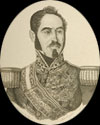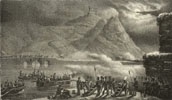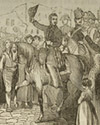19th Century´s militar history in the Basque Country
 This son of a humble craftworker family was born in Granátula (Ciudad Real) in 1793. When the War of Independence broke out, he enlisted as a volunteer in 1808. In 1810, he started at the Military Academy of the Isla de León, where he reached the rank of sub-lieutenant. In 1815, now a lieutenant, he joined General Morillo's expedition to defend Spanish control of the South-American colonies. It was around this time that he began to sympathise with Liberal ideology and the action he took against supporters of independence led to him being promoted to the rank of brigadier. After the defeat at Ayacucho marking the end of Spanish domination in South America, he returned to Spain in 1825.
This son of a humble craftworker family was born in Granátula (Ciudad Real) in 1793. When the War of Independence broke out, he enlisted as a volunteer in 1808. In 1810, he started at the Military Academy of the Isla de León, where he reached the rank of sub-lieutenant. In 1815, now a lieutenant, he joined General Morillo's expedition to defend Spanish control of the South-American colonies. It was around this time that he began to sympathise with Liberal ideology and the action he took against supporters of independence led to him being promoted to the rank of brigadier. After the defeat at Ayacucho marking the end of Spanish domination in South America, he returned to Spain in 1825.
 When the first Carlist War broke out, he asked to serve in the northern provinces in Cristine army lines. On the 1st of May 1834, he was appointed commanding general of the Basque provinces. In the summer of 1836, he replaced General Femández of Córdoba as leader of the Northern Army. In this position, he led the decisive Battle of Luchana that forced the Carlists to raise the siege of Bilbao at Christmas in 1836. He was awarded the title of Count of Luchana for his service.
When the first Carlist War broke out, he asked to serve in the northern provinces in Cristine army lines. On the 1st of May 1834, he was appointed commanding general of the Basque provinces. In the summer of 1836, he replaced General Femández of Córdoba as leader of the Northern Army. In this position, he led the decisive Battle of Luchana that forced the Carlists to raise the siege of Bilbao at Christmas in 1836. He was awarded the title of Count of Luchana for his service.
 From this time on, Moderate Liberals and Progressives quibbled over making him the leader of their respective parties. In the summer of 1839, following negotiations with Carlist sectors led by General Maroto that desired an agreement with the Cristines, Espartero and Maroto signed the Bergara Convention, bringing peace to the north. The Catalan Carlists refused to recognise the Convention so Espartero embarked on an expedition through the Maestrazgo to forced Cabrera and his army through Catalonia and into exile. He was awarded the title of Duque de la Victoria for this service.
From this time on, Moderate Liberals and Progressives quibbled over making him the leader of their respective parties. In the summer of 1839, following negotiations with Carlist sectors led by General Maroto that desired an agreement with the Cristines, Espartero and Maroto signed the Bergara Convention, bringing peace to the north. The Catalan Carlists refused to recognise the Convention so Espartero embarked on an expedition through the Maestrazgo to forced Cabrera and his army through Catalonia and into exile. He was awarded the title of Duque de la Victoria for this service.
It was as a result of this that Espartero put his sword at the service of Progressive ideology in the world of politics. In 1840, he objected to the Councils Act, which led to a head-to-head with the Regent Maria Christina. This conflict between Espartero and the Crown encouraged the Progressive Juntista movement and the situation reached its climax on the 1st of September of 1840. María Christina renounced the regency and a ministerial regency was set up, presided over by Espartero. In May 1841, the Cortes appointed the Progressive leader regent. His regency lasted until 1843, and was a period with few signs of Progressive politics. He encouraged the freeing up of land by promoting the disentailment of church estates.
In October 1841, a Moderate uprising took place in the Basque Country with the support of the governments of Bizkaia and Gipuzkoa, which he himself put down. Despite having declared respect for the Fueros (regional charters) in the Bergara Convention, Espartero signed a decree to abolish the Fueros on the 29th of October 1841 in retaliation for the uprising. In doing so, he equated Bizkaia, Gipuzkoa and Álava to the rest of the Spanish provinces. When Espartero was overthrown in June 1843, the Moderate government partially restored the Fueros, though not fully. The move of the customs border from the Ebro to the Pyrenees was one of the measures that were left unreversed.
Espartero was forced into exile in England after his fall from power and did not return to Spanish politics until 1854, when he was appointed President of the Council of Ministers and inaugurated the Progressive Biennium. After the return to power of the Moderates in 1856, Espartero retired from politics and went to live in Logroño. His final political episode took place when he was offered the Crown by Prim in 1870, though he did not accept. He died in Logroño in 1879.

